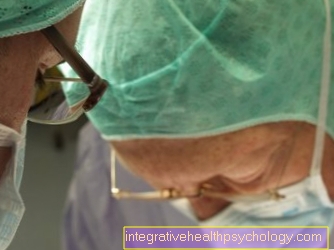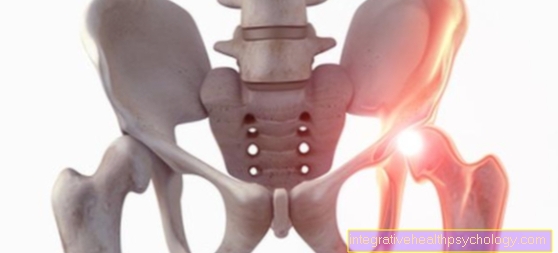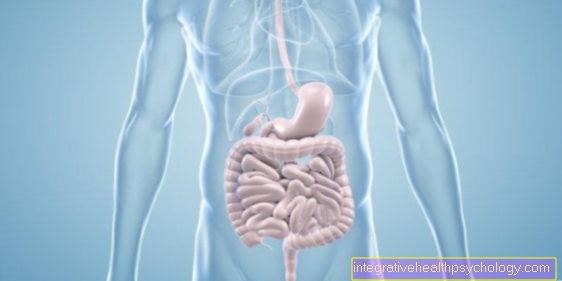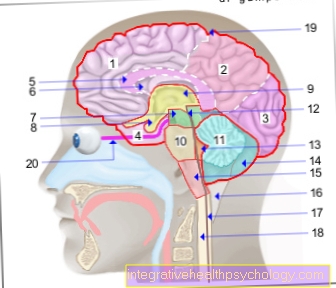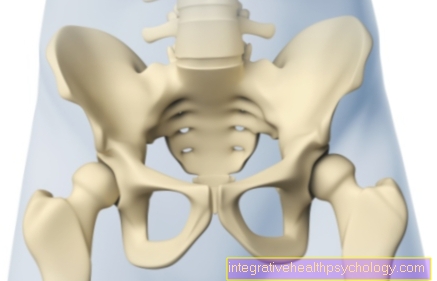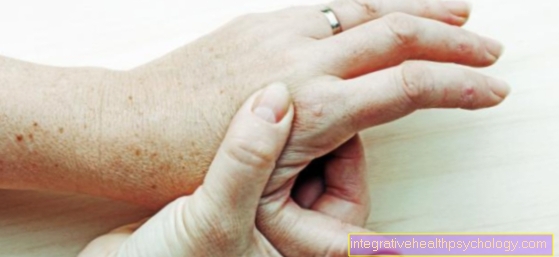Hyperthyroidism
Synonyms in the broadest sense
Hyperthyroidism, Graves disease, immunogenic hyperthyroidism, Iodine deficiency goiter, goiter, hot knots, autonomic nodes in the thyroid gland.
definition
An overactive thyroid (hyperthyroidism) occurs when the thyroid gland produces more thyroid hormones (T3 and T4), so that an excessive hormone effect is achieved on the target organs. Usually the disease is based on a disorder in the thyroid gland itself.
The thyroid hormones cause an increase in the overall metabolism and a promotion of growth and development. In addition, the hormones influence the muscles, the calcium and phosphate balance, they stimulate protein production (= protein biosynthesis) and the formation of the sugar storage substance glycogen.
introduction
The thyroid hormones L-tetraiodothyronine (= T4), also called thyroxine, and
L-triiodothyronine (= T3) have various effects and sites of action.
The release of thyroid hormones is controlled via a closed control loop:
The hormone TRH (= thyrotropin releasing hormone) is released from the central nervous system and acts on the pituitary gland, which now increasingly produces TSH (= thyroid stimulating hormone, thyroid stimulating hormone) and releases it into the blood.
TSH works on the thyroid: The thyroid cells are stimulated to produce hormones, so that T3 and T4 are subsequently released.
Outside the thyroid gland, T4 is converted to T3, which is the more active of the two hormones. The release of thyroid hormones into the blood, in turn, as part of a feedback reaction in the control loop, means that less TRH and thus TSH are released. The concentration of the thyroid hormones T3 and T4 in the blood is the basis of this regulatory cycle.
Also read our general article on metabolic disorders: Metabolic Disorder - What does it mean?

Anatomy of the neck / larynx
- throat
- Thyroid cartilage of the larynx
- thyroid
- Windpipe (trachea)

- Epiglottis cartilage -
Cartilago epiglottica - Hyoid bone - Os hyoideum
- Thyroid cartilage-hyoid bone ligament -
Thyrohyoid ligament - Upper thyroid cartilage incision
Incisura thyroidea superior - Thyroid cartilage -
Cartilago thyroidea - Ring Cartilage Brace -
Arcus cartilaginis
cricoideae - Thyroid -
Glandula thyroidea - Ring band -
Ligament annular - Tracheal cartilage -
Cartilago trachealis - Nasal cavity - Cavitas nasi
- Oral cavity - Cavitas oris
- Throat - Pharynx
- Lungs - Pulmo
Airway L - L (blue)
Feed route S - S (red)
You can find an overview of all Dr-Gumpert images at: medical illustrations
Symptoms
The symptoms of an overactive thyroid can be varied. However, on closer inspection, it becomes clear that each of them is due to overactivation of the body. In their overall picture, the following symptoms are considered to be Hyperthyroidism designated. One of the typical complaints Hyperthyroidism Mainly insomnia, increased irritability and nervousness and tremors. Each of these symptoms can be viewed as a sign of general psychomotor restlessness. In addition to these complaints, the cardiovascular system also suffers from excessively high thyroid levels. In addition to increased blood pressure and an increased heart rate, there are more and more cardiac arrhythmias. Extrasystoles (heartbeats outside the normal heart rhythm) and atrial fibrillation can even take on life-threatening dimensions.
Despite the described increased activity of the body and a feeling of ravenous appetite, unwanted weight loss occurs. This is due to a mobilization of the fat and sugar reserves. In some cases, this is accompanied by an excessively high blood sugar level and heat intolerance. Other symptoms include diarrhea, muscle weakness, osteoporosis and hair loss. In women there are also menstrual disorders up to and including infertility. Over time, an overactive thyroid also leads to a growth of the thyroid tissue (goiter), which becomes palpable as a swelling. In later stages this can even become visible from the outside and can assume such proportions that breathing and swallowing difficulties occur due to compression of the trachea and esophagus.
In the autoimmune overactive thyroid gland, Graves' disease, the protrusion of the eyes from the eye sockets (exophthalmos) is also noticeable. This is caused by an inflammatory swelling of the tissue surrounding the eyes. The combination of exophthalmos, increased heart rate (tachycardia) and goiter is called the Merseburg triad.
All of the symptoms mentioned occur quite frequently overall, but in most cases patients are only affected by some of the symptoms.
Are you dizzy and suspected thyroid disorders?
Read more about this Dizziness and thyroid, hot flashes and thyroid
Weight loss
A typical symptom of an overactive thyroid (hyperthyroidism) is weight loss. The Weight gain however, the classic symptom is one Hypothyroidism (Hypothyroidism).
The cause of weight loss lies in the increased release of the thyroid hormones, which the Basal metabolic rate of the body increase. The breakdown of the body's own fat and sugar reserves is promoted in order to provide the organs with more energy. The result can be an increased blood sugar level. However, not only fat and sugar reserves are depleted, at the same time also Calcium released from the bones (resulting in osteoporosis) and the build-up of proteins, for example in the muscles, inhibited.
frequency
Women are five times more likely to have an overactive thyroid than men. 2% of all women will develop clinically visible hyperthyroidism in their lifetime.
Cause / origin
Three forms of hyperthyroidism can be distinguished:
1) Graves' disease / immunogenic hyperthyroidism
In Graves' disease, there are autoantibodies against the receptor for the thyroid-stimulating hormone TSH (Thyroides stimulating hormone),
i.e. The immune system reacts against the body's own structures (= autoimmune disease).
The TSH receptors transmit the central nervous system's stimulus to the thyroid gland to produce the hormones T3 and T4 and release them into the bloodstream.
The receptor antibodies cause permanent stimulation of the thyroid gland, so that the corresponding hormones are formed in excess.
Graves' disease is characterized by an overactive thyroid with a goiter (= thyroid enlargement or swelling of the organ) and an increase in heart rate, an orbitopathy, i.e. there is an eye involvement, as well as a dermopathy (= skin disease).
This typical triple combination of symptoms (hyperthyroidism with its consequences, eye and skin involvement) in Graves disease is called the Merseburg triad.
Read more on the topic: Graves disease
2) Hyperthyroidism with thyroid autonomy
Thyroid hormone production is decoupled and independent (autonomous) from the processes of the control cycle.
The most common cause of these autonomous areas is iodine deficiency goiter.
A goiter, the enlargement of the thyroid gland, arises from iodine deficiency as a maladaptation of the metabolic situation:
Iodine is an important component of the thyroid hormones. If there is too little iodine in the human body, insufficient amounts of thyroid hormones can be produced: The concentrations of T3 and T4 in the blood decrease, so that increased stimuli for the production of hormones from higher-level centers, in the form of TRH and TSH, to the thyroid gland be handed in.
TRH and TSH stimulate the production of thyroid hormones and the growth of thyroid cells. Despite enlarged cells (= cell hyperplasia of the thyroid gland), hormone production cannot be increased because iodine is missing.
The thyroid hormone concentration consequently remains at a low level and growth stimuli continue to act on the thyroid.
The iodine deficiency goiter shows the increased tendency towards the development of autonomous areas which are not integrated into the control circuit of the thyroid hormones and produce hormones independently of the feedback mechanism.
In every thyroid gland, including the healthy one, there are autonomous areas, but in iodine deficiency goosene their proportion of thyroid tissue is increased.
The amount of autonomously formed hormones depends on the mass of the independent thyroid areas and the iodine intake.
If the autonomously produced hormone amount exceeds the physical requirement, the thyroid gland is overactive. This condition occurs when iodine is administered in high doses, e.g. taking medication containing iodine or injecting an x-ray contrast agent containing iodine before an X-ray examination. The additional iodine administration enables an increased production of hormones in the enlarged thyroid cells, so that the overactive thyroid becomes manifest, i.e. Causing symptoms.
The intake of small amounts of iodine, such as those ingested with food, does not, however, trigger an overactive thyroid.
3) Hyperthyroidism is less common in primary diseases such as Inflammation of the thyroid, thyroid hormone administration or malignant thyroid tumors.
Also read: Hyperthyroidism due to a pituitary tumor
Benign nodules, as is the case with an autonomic adenoma, also lead to an overactive thyroid. Read more about this clinical picture below: Autonomous adenoma of the thyroid gland
pregnancy
The most important requirement for the healthy development of an unborn child is a healthy mother. Especially during the first few weeks and months of pregnancy is one good maternal thyroid function important. During this time, an overactive thyroid in the mother often results in premature or even stillbirth.
Pregnancy is especially not recommended for patients with Graves' disease. On the one hand, the rate of early abortions is significantly increased by thyrostatic therapy, on the other hand, those responsible for the clinical picture are increased antibody placental transferred to the fetus and can damage it during the first years of life or even for life.
On the subject of high thyroid levels and pregnancy, it should also be mentioned that pregnancy too normal changes of thyroid functions. Since the mother's thyroid now also has to take care of the child, it comes to one increased need on iodine. The mother should at least during this time 200 µg iodine per day take in with food. At the same time, the thyroid gland may grow slightly during this time. A slight deviation in thyroid values is not uncommon during pregnancy.
However, an excessive increase in the size of the thyroid gland or a strong change in the values should be further clarified, since a previously irrelevant thyroid dysfunction can intensify and become manifest during pregnancy.
With children
In children in particular, it is important to recognize thyroid dysfunction in good time. An overactive thyroid gland (hyperthyroidism) can lead to a variety of symptoms. This typically includes a enlarged thyroid, a fast pulse, high blood pressure, Tremble of the extremities and possibly protruding eyes.
The cause of an overactive thyroid in children can on the one hand (usually benign) Lump (adenoma) of the thyroid gland, which, decoupled from the normal control system of the thyroid gland, produces thyroid hormones. Other causes can be autoimmune processes, an overdose of thyroid medication, or transmission of thyroid antibodies by the mother during pregnancy.
Usually, hyperthyroidism in children is discovered quickly, as appropriate blood values already during the first days of life be examined as part of the U2 investigation. If there is evidence of a corresponding functional disorder, ultrasound examinations or, in exceptional cases, one can be performed Scintigraphy secure the diagnosis. Depending on the cause, the treatment is then carried out either with medication or surgically. Also one Irradiation of the thyroid using radioactive iodine administered intravenously can be considered. Follow-up care consists of adequate iodine intake and possibly hormone replacement therapy.

Figure hyperthyroidism
Scintigraphy of a patient with an overactive thyroid gland (hyperthyroidism). The uptake of radioactively marked iodine is greatly increased over the entire thyroid gland / both thyroid lobes.
From this it can be deduced that the thyroid function is excessive (thyroid overfunction).
This suspicion can be confirmed by determining the so-called thyroid gland values in the blood.
diagnosis
In the survey of the medical history (= anamnesis) it must be asked whether iodine-containing medication was taken or iodine-containing ointments / tinctures were applied to the skin or whether an examination was carried out with an X-ray contrast medium containing iodine. This additional iodine intake could lead to an overactive thyroid.
The symptoms of an overactive thyroid gland (hyperthyroidism) will be determined on clinical examination, e.g. an increased heart rate and high blood pressure, or asked.
The physical examination of the patient is followed by a check of the metabolic status:
There is a Laboratory control, at which the level of thyroid hormones T3 and T4 as well as the TSH concentration in the blood are determined: The concentrations of the hormones T3 and T4 are increased and the TSH level is reduced due to the negative feedback from the thyroid hormones to the higher-level centers.
If Graves' disease is suspected, the TSH autoantibodies can be detected in the blood.
The imaging procedures used to diagnose an overactive thyroid include ultrasound (= sonography) and Scintigraphy.
Of the Ultrasonic is an indispensable method to determine thyroid diseases: Statements on abnormalities in the structure of the tissue and the echo pattern of the thyroid as well as the determination of the volume of the organ are possible.
If there is hyperfunction, there are many hypoechoic thyroid areas that appear black on the ultrasound image. The blood flow to the thyroid gland is increased, which can be determined by a Doppler examination (= sonographic method for measuring the flow rate of the blood in the vessels).
The scintigraphy is a radiological examination with the help of which hormone-producing, active cells of the thyroid gland can be visualized.
The Scintigraphy is primarily used to diagnose autonomous thyroid areas.
For their representation, stable iodine is coupled to radioactive technetium and administered to the patient via the vein. The uptake of iodine in the thyroid is therefore linked to the uptake of the radioactive marker, so that the extent of the iodine uptake can be quantified via the representation of the marker in the scintigraphic image. If there is an overactive thyroid gland (hyperthyroidism), a lot of iodine and thus a large amount of technecium are absorbed by the thyroid gland.
The areas with stronger storage that one hot knots speak for the presence of autonomous thyroid areas.
Also read: Thyroid Removal.


